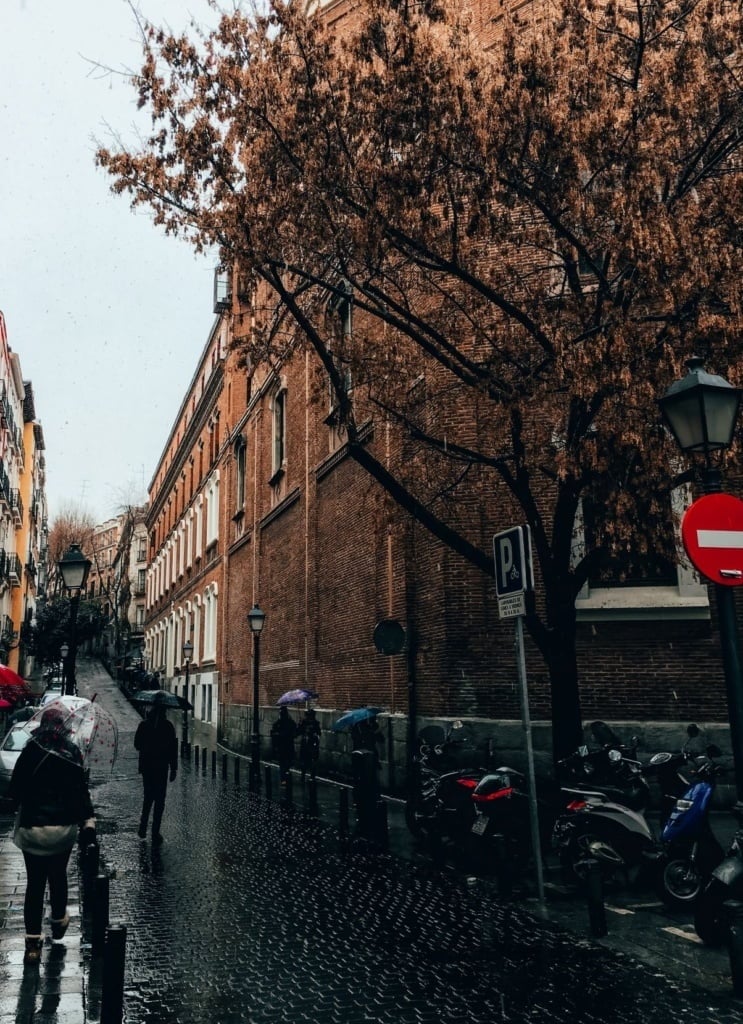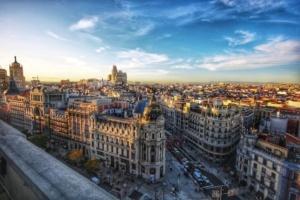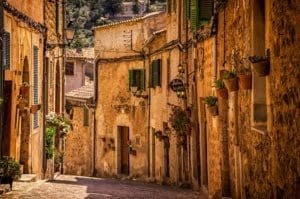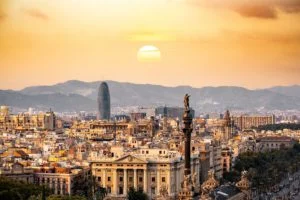Having lived in Mexico, I was always interested in traveling to Spain. The histories of both are so much intertwined. Madrid in particular fascinated me. Madrid is the biggest city in Spain and is both the seat of the government and alongside Barcelona and Ibiza, is one of the biggest centers for tourism in the country. Spanning almost six and a half million inhabitants, the city functions as its autonomous community and while it is the center of the Spanish government it is anything but stuffy and boring. The city is home to a number of museums, world-class restaurants, and some of the best nightlife that you can find in Europe. Whether you’re looking to let loose or experience the centuries-old culture, there’s a little something for everyone.
The city layout and lifestyle is largely influenced by its past Royal History. Madrid sits just a little northeast of the center of the Iberian Peninsula and is characterized by its large medieval castles, ornate buildings, and cathedrals that blend seamlessly with the modern world. Madrid brings in plenty of tourists while there are tons of must-see things there are also more esoteric ones as well. So check out some of the best things to see and do in Madrid.
Hang out in Retiro Park
Madrid is a thriving and bustling city that’s large and constantly in flux with the people going through it whether they be local or tourist. In the heart of the city is the beautiful Retiro Park. The park is a perfect way to get to some green space in the middle of the city and take a break from the hustle and bustle of city life. The park was formerly royal property until the 19th-century until it was opened to the public. The park is popular with locals with kids hanging out by the pond or if you’re so willing, hop on a paddle boat and cruise around the Grand Pond or check out the iron and glass pavilion built to house the Philippine Exhibition in 1887. The park is also interestingly home to the city’s oldest tree; the Montezuma Cypress that was planted in 1633 and is still thriving.

Hang out in Retiro Park like a local.
Spend hours in The Prado
The Prado Museum is one of the country’s more important cultural centers to check out. While this recommendation falls more along the line of a “typical tourist” thing to do, the fact remains that The Prado is an essential museum to check out and probably ranks among some of the best in Europe. The Prado is home to a vast array of art collections from renaissance masterpieces to Baroque sensations. Guests to the museum can spend days here without having seen everything. Some of the stand-out masterpieces are from the Spanish collection which includes works from Velasquez and El Greco. While Bosch’s Garden of Earthly Delights and Caravaggio’s Head of Goliath are stand-outs in the Italian collections.
People Watch at Plaza Mayor
If you’re looking for a low-budget thing to do that makes you feel like you’re taking part in the scenery and culture of Madrid, check out the historic Plaza Mayor. First built in 1619, the large plaza in the heart of the city brings in tourists, locals, and everyone else in between to come to hang out, check out the restaurants or maybe grab an afternoon drink. The plaza was originally used as a public market space and has since been the site of coronations, bullfights, and executions. Now it hosts its annual Christmas market and is a central part of town to hang out and do a little people watching.

People watch at the Plaza Mayor and grab a drink a local restaurant.
Hunker down in the Parque el Capricho Bunker
A relic from Spain’s less-than-savory past is now one of the weirdest spots in the city to check out, and one you probably won’t find in a majority of tour guides. Located in el Capricho park the bunker dates back from the Spanish Civil War. The park was originally on the property of the Duchess Osuna Maria Josefa Pimentel. The park was on private property and designed in an English garden aesthetic. Throughout the 19th century, the park was used for high-society gatherings but even during the French invasion in 1808, the park’s location was known to be a strategic one. Afterward, the park returned to the ownership of the Duchess until the Spanish Civil War.
Covered amongst the brush and the green heavy foliage, Republican Forces built the bunker and it was known as “Posicion Jaca”. It was built to be used as a last-resort position to defend Madrid from Nationalists and high-ranking Republicans who could take refuge in the bunker. The bunker was designed to withstand bombs and could house over 200 people complete with electricity, offices, bathrooms, ventilation, and communications systems. Now the bunker is a weird place to visit that’s a little more on the adventurous side. It’s free to get into but don’t bring food or pets along.
Eat at the World’s Oldest Restaurant
In the world of restaurant ownership, especially in a place like Madrid where there is some amazing food everywhere you go, it’s nothing short of a miracle that Sobrino de Botin has managed to last over 200 years. Sobrino de Botin is recognized officially by the Guinness Book of World Records as the “world’s oldest restaurant”. It opened in 1725 and at the time was an inn with a restaurant on the ground floor. It wasn’t much of a restaurant in the same way we understand it today but rather people would bring the ingredients in and have the cook make them something. The original owners died childlessly and passed the restaurant onto their nephew, which is where the name comes from.
Over two hundred years, Spain has changed tremendously but the restaurant has changed very little. Adding some extra dining spaces and four more rooms each with its Spanish theme as well as the fancy Felipe IV dining room, the restaurant cooks the most traditional Spanish cuisine with the star dish being the suckling pig slow-roasted in a brick oven. Although the restaurant is in the Guinness Book of World Records, it arguably saw its first moment of fame when it was mentioned in Ernest Hemingway’s The Sun Also Rises and Death in the Afternoon where he mentions “It is one of the best restaurants in the world…I ate a very big meal and drank three bottles of rioja alta”

Read Hemingway’s book the Sun Also Rises or Death in the Afternoon at the Sobrino de Botin restaurant.
Stroll down the Gran Vía
If there’s any good way to get a feeling for a city it’s to stroll down its central-most boulevards. The Gran Vía is the grandest boulevard in the city and is practically living proof that life is alive with the boulevard sort of taking up different personalities during different times of the day. Gran Vía is home to shops and luxury stores from upscale designer brands to household names like Zara and H&M. During the daytime shopping and dining is the big activity here as well as architecture aficionados admiring the diverse plateresque, art deco, neo-Mudejar buildings that make the street stand out. In the evening you’ll see couples going in and out of restaurants hand-in-hand or emerging from the local theaters or cinemas, while finally, later in the night time the clubbing crowd descends on the Gran Vía while the street pulses with the beat of the clubs.

Get a feel for the city and stroll down the Gran Via.
Get a dose of the creepy at Reverte Coma Forensic Museum
Tucked away in a corridor in the University of Madrid’s faculty of medicine is this weird and macabre museum dedicated to all things ghastly. The Reverte Coma Forensic Museum is open to the public but is not for the faint of heart and is kept within the walls of medical academia for a good reason.
The museum has about 1,500 different pieces on display some of which are deformed skulls of ancient creatures, severed heads from past executions, children’s skeletons, diseased bones, and torture devices. But the medical and bodily oddities aren’t the only ghastly things on display at the museum. There is also a large collection of tools and objects like pre-Columbian Andean mummies, weapons made by inmates, antique pharmaceuticals, toxicology displays of poisonous plants and animals, and about 800 skulls.
Despite the obvious grotesque theme of the museum, the purpose of it isn’t to actually horrify its visitors but rather the intent is to educate its visitors and students by offering real and direct contact with the tools and subjects for those interested in forensic science and criminology. In fact, a lot of knowledge gained by the museum helped solve many murder cases in both Spain and abroad.
Party all night at Medias Puri
Madrid is known for some of the best nightlife in Europe and there’s a bit of a Spanish stereotype that people only start going out to party at midnight. In the case of Medias Puri that might be true. Passing by the facade of the building you wouldn’t think twice that behind the closed doors are one of Madrid’s biggest nightclubs. On the surface, the building is a storefront that seemingly sells women’s undergarments but Medias Puri is a huge nightclub with three floors that can fit up to a thousand people. The shows here are legendarily wild and the cocktails are just as well-known. They also have an amazing food menu that you wouldn’t expect to see at a nightclub. Don’t expect to get in if it is not a Saturday or Friday night and even then the doors don’t open until 11:30 and usually don’t close again until around 5:30 am.
Satisfy your sweet tooth at San Ginés
For those out there looking for a sweet treat, the chocolate drinks and churros at San Ginés are among some of the best in the city. The spot doesn’t close and due to the popularity of the restaurant and its churros they had to introduce a pre-paid ticketing system to deal with the people emerging out of the clubs at 5 am looking for a snack. San Ginés has been around since 1894 and their recipes have hardly changed. It’s one of the few places in the city where exhausted clubbers and chipper old ladies converge together in the quest for something sweet.

Satisfy that chocolate craving at San Gines.
Enjoy a delicious evening of Tapas
This suggestion can take you all over the city and depending on what you want and what you’re looking for there are tons of different options for tapas around Madrid. Tapas are not exactly appetizers and they can be either hot or cold dishes usually in a bite-size or served on a small dish. It’s meant to be eaten while you drink (mostly wine). Some of the best in the city are croquettes from Santerra that are made with Iberian ham and cheese served at the optimal crispiness, patatas bravas from Docamar, or boquerones which are salty little fish served in vinegar and eaten with a tortilla and washed down with a cold beer.
Our Final Word
Madrid is one of Europe’s major tourist capitals and there’s a good reason why people from all over the world flock to it. Gorgeous medieval buildings and grand boulevards mix the old and the new along with the eclectic and the modern. It’s a party place but it’s also a cultural hub, it’s fun but it’s also traditional and it’s waiting for you to discover it! You don’t have to spend a lot of money to enjoy real Madrid.
Related Posts
I weep for America
I woke up this morning feeling a sense of doom in the world. I feel that I do not even know the country that I live in any longer. As someone that travels throughout the world and tries to make connections with the people and wildlife that I come across, it was incredible that America elected someone like Donald Trump. It is incredible that people would vote against their own best interest and seem to be happy about it. It is incredible how many racist, misogynistic and uneducated people there are in America.
Conservation Champions: 5 Exemplary Wildlife Preservation Efforts Making a Difference
Conservation Champions highlights five remarkable wildlife preservation efforts that are truly making a difference. From protecting endangered species to restoring habitats, these initiatives showcase the dedication and innovation of individuals and organizations committed to safeguarding our planet’s biodiversity. Discover the inspiring stories behind these exemplary conservation projects and the impact they have on our natural world.
Beyond the Big Five: Discovering Wildlife Wonders in Non-African Safari Destinations
“Beyond the Big Five” takes you on a thrilling journey to lesser-known safari destinations outside of Africa. From the lush rainforests of the Amazon to the vast plains of the Pantanal in South America, this article uncovers the hidden treasures of wildlife wonders that await adventurous travelers seeking a unique and unforgettable safari experience.











0 Comments